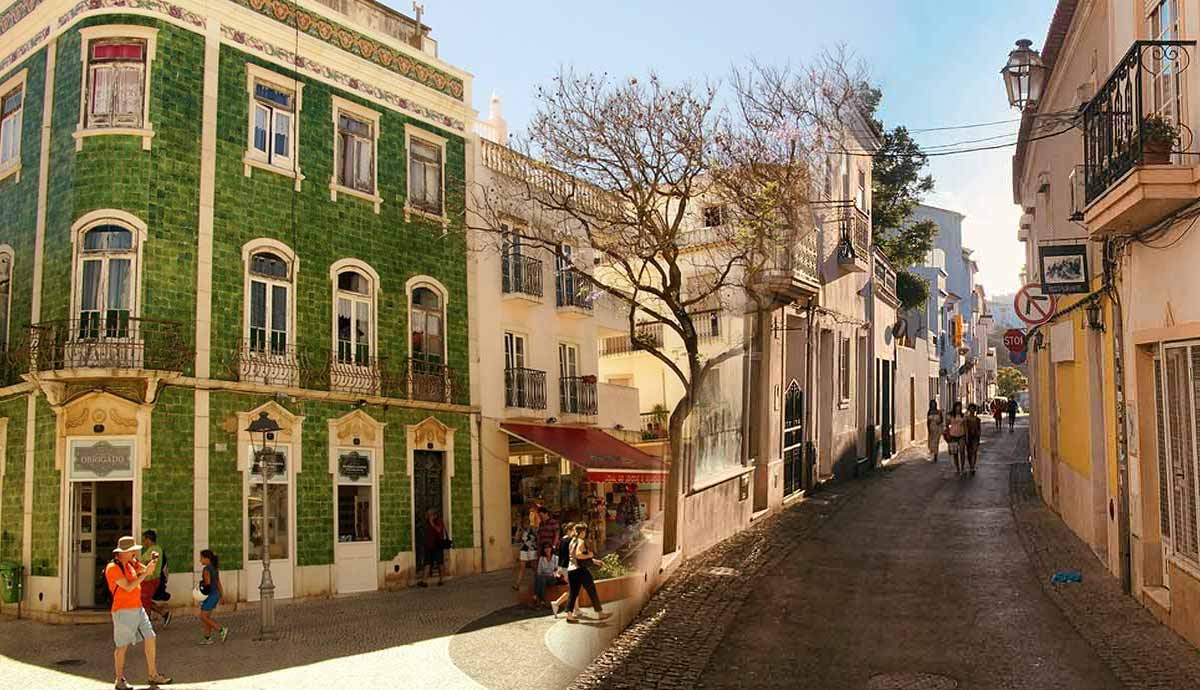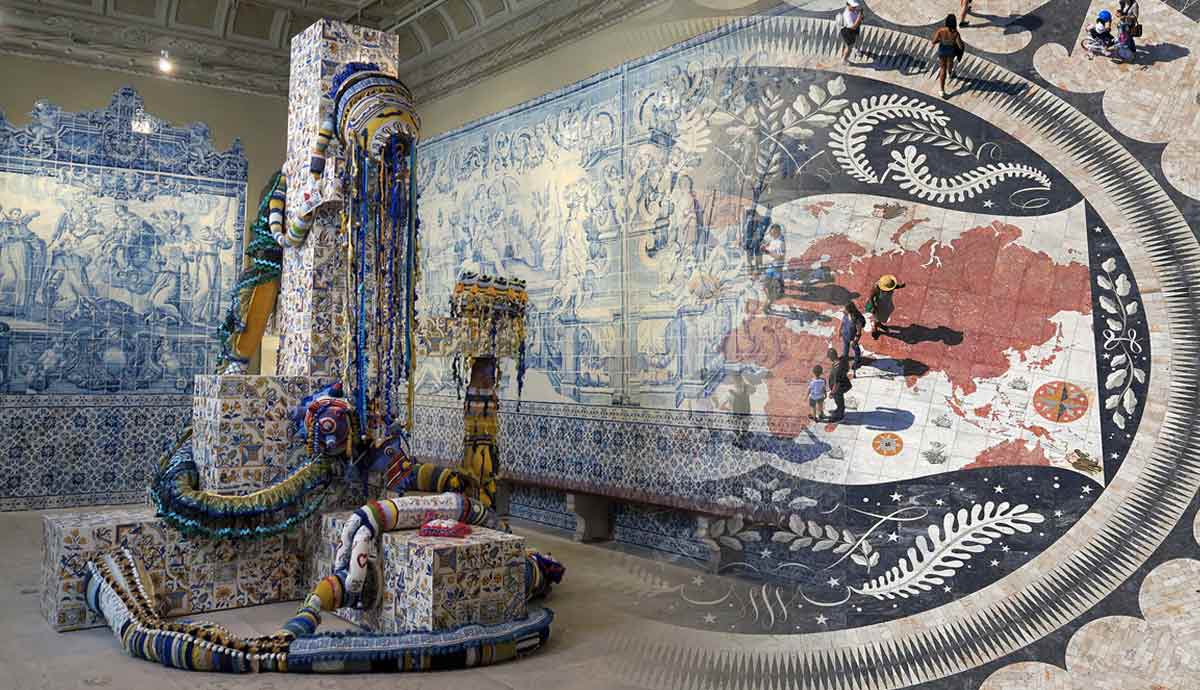
In Faro, you will marvel at the Moorish and Medieval buildings that stand beside the stunning Baroque and Neoclassical monuments that define the city’s landscape. In this article, we will show you the city’s iconic must-visit landmarks.
1. Milreu Roman Ruins

Located nine kilometers (5.5 miles) away from Faro city center, the Milreu Roman Ruins are a must-see. This archaeological site is one of the most significant in Portugal and has been considered a National Monument since 1910.
Here, you can admire a wealthy Roman villa and the attached baths, a temple, mausoleums, and several industrial and commercial buildings. What makes this location famous are the thermal baths, the temple, and its mosaic panels.
Milreu was inhabited between the 1st and the 10th century. Throughout such a long period, the villa underwent several renovations, and the temple, built in the 4th century, was later used by the Christians and the Moors.
2. Faro City Walls

Faro’s city walls are a military defensive building in the oldest part of the city, also known as the Vila Adentro. Historians believe the original walls predate the Roman occupation. In the 9th century, the Moors rebuilt the walls, and two Albarran towers were added at Arco do Repouso, one of the main gates.
During the Reconquista, the walls were severely damaged. So, King Afonso III ordered its reconstruction. Later, the walls were repaired under King João III’s reign in the 16th century. The works extended for a long period of time due to the invasion attempt of Robert Devereux, 2nd Count of Essex.
The 1755 earthquake devastated most of Faro, including the city walls, and over time, the city lost its importance as a military stronghold. As a result, instead of rebuilding the city walls, they were integrated into new buildings. Today, you can see some portions of the walls that remain uncovered.
3. Arco do Repouso

The Arco do Repouso is one of Faro’s oldest buildings. Built by the Islamic Governor Yahya ibn Bakr, it dates to the 12th century. At the time, this was one of the main gateways. As the Reconquista progressed in the 13th century, the Moors reinforced this entrance with two Albarran towers.
Inside one of the arches is a chapel built in the 18th century under the patronage of Queen Mariana to house the image of Our Lady of Rest.
The name Arco do Repouso (Arch of Rest) comes from two different myths. One states that the armies of King Afonso III rested here after conquering the city in 1249. However, the second myth tells of the love story between the Moorish Governor’s daughter and a young Christian knight who was condemned by her father to stay here forever.
4. Faro Cathedral

Faro’s cathedral, also known as Igreja de Santa Maria de Faro, was built in 1251 over the remains of a Mosque, where there once stood an ancient Paleochristian basilica.
The building still preserves a few architectural elements of the original building, dating from the 13th century, such as the bell tower and two chapels of the cross.
In 1577, Faro Cathedral was elevated to the episcopal see of the Algarve Diocese, replacing Silves. In 1596, the church and the town were sacked and set on fire by the English troops of Robert Devereux, 2nd Count of Essex. Only the chancel chapels, the façade tower, and the nave walls remain from the Gothic original, while the altars and wooden ceilings were destroyed.
The interior was rebuilt in the 17th century in a Mannerist style and enriched with several works of gilded woodwork. Although the 1755 earthquake damaged the cathedral, the following reconstruction works left the church unaltered.
Inside Faro Cathedral you can admire the altarpiece and chancel chair, and the Chapel of the Holy Wood, covered in gilded wood carvings. Here, you can also observe the founding bishop’s tomb.
5. Igreja da Misericórdia — The Church of Mercy

In 1583, Bishop Afonso de Castelo Branco ordered the construction of Igreja da Misericórdia in the same location where one stood the Espirito Santo hermitage, built in 1499 by King Manuel I. Igreja da Misericórdia is the only church in the Algarve with a Greek cross plan.
After the 1755 earthquake, Igreja da Misericórdia was severely damaged. Bishop Francisco Gomes ordered its reconstruction, starting with the façade refurbishment and the building of a new hospital. Italian architect Francisco Xavier Fabri was responsible for the reconstruction works.
Some of the most impressive features inside the church include the 17th-century Mannerist gilded wood altarpiece, a series of paintings, and a holy water font designed from a Gothic capital.
The earthquake of 1755 caused major damage, which led Bishop Francisco Gomes (1795-1815) to remodel the façade and build a new hospital, according to the design of the Italian architect Francisco Xavier Fabri, who is also responsible for designing the Arco da Vila, located on the other side of the square.
6. São Francisco Convent

Convento de São Francisco, also known as Church and Convent of the Third Order of São Francisco, was built in 1529 by the Capuchin friars of Província da Piedade. Lady Branca de Vilhena and her son Nuno Rodrigues Barreto, Faro’s governor, granted the land and sponsored the convent construction.
Shortly after its construction, the convent became too small for its many worshipers. That is why the building underwent several enlargements that lasted between the 18th and 19th centuries.
You can find 18th-century tile panels in the chancel walls and vaults, with a valuable polychrome panel in the center depicting the Coronation of the Virgin. These tiles are part of the 18th-century Master’s Cycle and were made between 1720 and 1730. There is also a set of 18th-century Italian paintings depicting the life of Saint Francis.
Today, the Convento de São Francisco holds the Hotel and Tourism School.
7. Arco da Vila

The Arco da Vila is a National Monument located in Faro downtown. This impressive construction was built over Portas da Rainha, one of the city’s medieval gates. In 1812, Bishop Francisco Gomes commissioned the arch’s design and construction from Italian architect Xavier Fabri.
The arch is decorated with an Italian image of St. Thomas Aquinas, which makes it one of the finest examples of Italian Neoclassicism in the Algarve.
Inside it is the Arab Gate and the remains of the old Moorish walls, the city entrance for those coming into Faro from the sea. This is a unique example of Arab architecture in Portugal, considering it stands in its original location and how well-preserved it is.
8. Igreja de Nossa Senhora do Carmo

Igreja de Nossa Senhora do Carmo is one of the most important historical monuments in the Algarve and one of the best examples of Baroque architecture. It was founded in 1713 by Bishop António Pereira da Silva within the medieval city walls.
The original façade and central body were demolished to make way for a newer and larger building designed by Mason Diogo Tavares. The construction works finished in 1755, the year of the infamous earthquake. After the natural catastrophe, the chancel façade was rebuilt in the late Baroque style.
The gilded altars are the highlight of the church’s interior decoration. The chancel altarpiece, made by master Manuel Martins in 1737, is the first example of the Joanine style in the Algarve.
Other altarpieces, also from the 18th century, especially the one in the Chapel of São José, are a good example of Rococo carving in the Algarve. Another interesting feature is the Baroque organ visible in the high choir, which has recently been restored.
In 1816, the Chapel of Bones was added to Igreja de Nossa Senhora do Carmo. The small chapel, located behind the main church, was made with the skeletons of more than 1,000 Carmelite friars retrieved from the Order’s ancient cemetery.

Once inside, you can contemplate the inscription Pára aqui a considerar que a este estado hás-de chegar, which translates to “Stop here and consider, that you will reach this state too.”
9. Belmarço Palace

The Palacete Belmarço is a bourgeois residential palace built in 1917. It is one of the most recognizable landmarks in Faro and it is the best example of Revivalist architecture in Portugal.
The Palacete Belmarço was built by the wealthy merchant Manuel de Jesus Belmarço as his own residence. The Portuguese architect Manuel Joaquim Norte Júnior was in charge of designing this impressive building.
The palace construction was part of a phase of urban renewal in Faro, during which the aim was to modernize the appearance of its buildings to keep up with the new trends in Lisbon.
Among the most intricate details are the façade partially covered in stonework, the moldings of the openings, masonry work, cornerstones, and ornaments. Inside are tile panels depicting the Tower of Belém, the Port of S. João do Estoril, and Pena Castle.
10. Faro Museum

Faro Museum is one of the oldest in the Algarve. Over its 100-year-old history, the museum was housed at several different addresses. Today, it is located in the Monastery of Nossa Senhora da Assunção, a classified National Monument.
Here, you can admire an impressive collection of archeological artifacts dating from Prehistory to the Roman occupation and the Middle Ages. Among the most important objects are a mosaic from the 2nd/3rd centuries, the imperial busts of Hadrian and Agrippina, and a collection of epigraphs from Ossónoba.
There is also a unique marble tombstone with epigraphs marking the construction of Porta do Sol Tower in Silves whose purpose was to reinforce the city’s defensive system. In the inscription, the Almohad Prince Abu l-Ula Idris is identified as the one who ordered the gate’s construction.
At the museum, you can also admire several paintings from the 16th to the 19th centuries that once belonged to religious temples in the Algarve.











